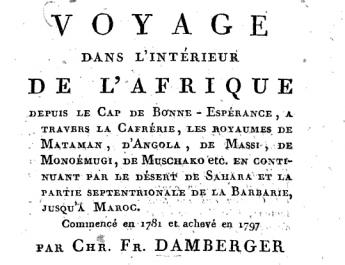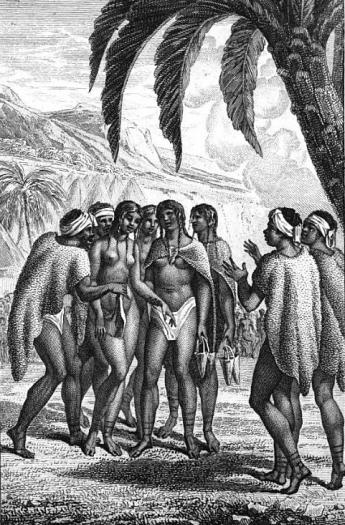Schrödter (Shoe-Maker), Taurinius (Printer), Damberger (Cabinet-Maker) - One Author, Three Travel Books

By Raymond John Howgego
Christian Friedrich Damberger, whose real name was possibly Zacharias Taurinius, is the pseudonymous author of, or collaborator on, three cleverly contrived hoax narratives of travel, the first published under the name of Joseph Schrödter, the second under the name of Taurinius, and the third under the name of Damberger. Because of their bibliographic relationship and probable common authorship, the three books are considered here together.
1. Schrödter
The narrative of Schrödter, titled See- und Landreise nach Ostindien und Aegypten, is an account of travels undertaken in 1795-1799, largely in the Middle East, visiting Sinai, Gaza, Damascus, Jerusalem, Bethlehem, the Dead Sea and other places. The author continues to India and embarks at Pondicherry in April 1797 only to be captured by the English and deposited at Alexandria in June. There he witnesses the conquest of Egypt by the French. The book was published in Leipzig in 1800 and never reprinted.
2. Taurinius
The narrative of Taurinius, titled Beschreibung einiger See- und Landreisen nach Asien, Afrika und America, presents the author as a native of Cairo, born in 1758, the son of a Copt named Stirish. Leaving Egypt, he travels via Constantinople to Riga and Nuremberg (where he changes his name and religion) then continues into India, Bengal, China and Japan. Returning by way of Batavia and the Cape of Good Hope, he explores into the interior of Africa, penetrating as far as the the Sahara and fighting his way against lions, tigers and cannibals, and being crowned king by numerous native tribes. First published in three volumes at Leipzig over the years 1799 to 1801, it was slightly more popular than that of Schrödter and was reprinted at Vienna in two volumes in 1804 under the title Lebensgeschichte und Beschreibung der Reisen durch Asien, Afrika und America des Zacharias Taurinius.
3. Christian Friedrich Damberger
The third excursion, titled Christian Friedrich Dambergers Landreise in das Innere von Afrika, proved immensely popular, not only in Germany but also in France and Great Britain. Damberger, who appears in the book as a Dutchman, sails from Amsterdam on 16 June 1781 and disembarks at the Cape of Good Hope on 19 September. After travelling some distance to the east he then heads due north into the country of the Hottentots and into ‘Caffraria’, a wooded country on what is now the borderland between South Africa and Botswana. Continuing north through Mataman, located around the headwaters of the Zambezi, he crosses the far interior of Angola and the lands of Matamba and Congo and arrives on the River Congo in Loango, some 300 kilometres from the coast. From here, around 5ºS, he takes a long diversion eastward to arrive at the northern tip of a great lake whose situation approximates to that of Lake Tanganyika. Heading northwest, he passes through the kingdoms of Monoemugi (now eastern D.R.C.) and Muschako (now central D.R.C.) and crosses Africa into ‘Soudan’ in the region of Lake Chad. After following the supposed course of the Niger to the west, and arriving around Timbuktu, he strikes due north across the Sahara to around 32ºN, then due westward to arrive on the Atlantic coast of Morocco.
Damberger’s Landreise in das Innere von Afrika was so carefully crafted from the travels of authentic explorers, and so rich in plausible detail, that it was immediately accepted as a genuine narrative. First published at Leipzig in two volumes in 1801, it was translated into French and English the same year. So popular was the English edition that it appeared in no less than seven versions in its first year, two of them printed in the United States. The hoax behind this and the previous narratives was almost immediately revealed in an anonymously-authored 19-page pamphlet titled Of the Shoe-Maker, Schrödter, the Printer, Taurinius, and the Cabinet-Maker, Damberger, a discussion of which was quickly published in numerous periodicals (see, for example, Intelligenzblatt der Allgemeine Literatur-Zeitung, no. 36, 28 February 1801; The European Magazine, vol. 39, March 1801; The Critical Review, vol. 32, 1801; The British Critic, vol. 17, 1801; and The Anti-jacobin Review, vol. 8, 1801; The Monthly Visitor, vol. 12, 1801; Le Spectateur du Nord, July 1801; and the anonymous article, ‘Fictitious Travellers’ Tales’, published in Crosthwaite’s Register of Facts and Occurrences relating to Literature, the Sciences, and the Arts, July 1861, pp. 14-15).
The story goes as follows:
In 1801 a man calling himself Damberger contacted Gottfried Martini, the Leipzig publisher, to whom he offered the copyright of a manuscript which purported to be a record of his travels in the interior of Africa. Martini read the manuscript with considerable interest and issued it to the public with considerable success. Almost immediately the fraud was exposed by articles in two German journals, the Literatur Zeitung of Göttingen, and the Allgemeine Literatur Zeitung (7 January 1801) of Jena, written by Professors Paulus and Meinors, which proved that the book was entirely copied from other books of travel, and chiefly from two volumes published not long before at Leipzig under the names of Julius Schrödter and Zacharias Taurinius. When Martini contacted the other Leipzig publishers to compare the Damberger manuscript with those of Schrödter and Taurinius, he found that all three were in the same handwriting. When Martini called upon Damberger to explain himself, the latter immediately confessed to the imposture and admitted to having collaborated on, or been partly responsible for the Schrödter and Taurinius publications. In addition, he alleged that his real name was Zacharias Taurinius, that he was a printer at Wittenberg, and that he had taken the name Damberger from a fellow Cape-bound voyager who had subsequently returned to Holland and was probably now in Surinam. With regard to the Schrödter publication, Damberger (alias Taurinius) insisted that Schrödter was a real person, a native of Hamburg, whom he had assisted only because the man was unable to write. Throughout the proceedings Damberger (Taurinius) continued to maintain the authenticity of his African narrative, as well as that published under the name of Taurinius. In fact, very little that Damberger (Taurinius) alleged was actually true and suspicion fell on ‘a certain Master of Arts’, a shadowy character from Wittenberg by the name of Junge, who appears to have written the greater part of Damberger’s African narrative and possibly the previous two.
Despite the uncertainty over the true authorship of Damberger’s African travels, current library catalogues almost invariably list the book under the name of Taurinius, which itself might be a pseudonym. Exposure of the account as a fraud brought printing to a rapid halt within the first year of publication and no further edition appeared until its inclusion in a collection published in 2001. Remarkably, there has been no discussion of this intriguing bibliographic mystery in recent literature.
Bibliography
Schrödter, Joseph (pseud?):
See- und Landreise nach Ostindien und Aegypten, auf die Berge Sinai und Horeb, nach Gaza, Rama, Damscus, Sydon, Tyrus, Jerusalem, Bethlehem, nach dem todten Meere u.s.w. in den Jahren 1795-1799, Leipzig, 1800.
Taurinius, Zacharias (pseud?):
Beschreibung einiger See- und Landreisen nach Asien, Afrika und America, vorzüglich von Holland und England nach Batavia, Madras, Bengalen, Japan und China, ingleichen vom Vorgebirge der guten Hoffnung durch die Kafferey und die Wüste Sahara nach Aegypten von einem gebohrnen Aegyptier Zacharias Taurinius... , Leipzig, 1799-1801, 3 vols (vol. 1: 1799; vol. 2: 1800; vol. 3: 1801)
Lebensgeschichte und Beschreibung der Reisen durch Asien, Afrika und America des Zacharias Taurinius, eines gebohrnen Aegyptiers... , Vienna, 1804, 2 vols.
Damberger, Christian Friedrich (i.e. Zacharias Taurinius?):
Christian Friedrich Dambergers Landreise in das Innere von Afrika, vom Vorgebirge der guten Hoffnung durch die Kaffarey, die Königreiche Mataman, Angola, Massi, Monomuegi, Muschako, u.a.m., ferner durch die Wüste Sahara und die nördliche Barbarey bis nach Morocco, in den Jahren 1781 bis 1797, Leipzig, 1801, 2 vols; Hamburg, 1930
French translation by L.H. Delamarre: Voyage dans l’intérieur de l’Afrique, depuis le Cap de Bonne-Espérance, à travers la Cafrérie, les royaumes de Mataman, et d’Angola, de Massi, de Monoémugi, de Muschako, etc., en continuant par le désert de Sahara et la partie septentrionale de la Barbarie, jusqu’à Maroc, commencé en 1781 et achevé en 1797, Paris & Strasbourg, An IX [1801], 2 vols
English translation by William Tooke as Travels through the interior of Africa from the Cape of Good Hope to Morocco; in the Caffraria, the kingdoms of Mataman, Angola, Massi, Monoemugi, Muschako, Bahahara, Wangara, Haoussa, &c., &c., and thence through the desert of the Sahara and the north of Barbary to Morocco, between the years 1781 and 1797, London, 1801, 2 vols in 1; London, 1801; Edinburgh & Dublin, 1801; London & Edinburgh, 1801; Dublin, 1801, 2 vols; New York, 1801, 2 vols; Charlestown, Mass. & Boston, 1801; in Tim Fulford (ed.), Travels, explorations, and empires: writings from the era of imperial expansion, 1770-1835, vol. 5, London & Brookfield, Vt., 2001.
[Anon.], Of the Shoe-Maker, Schrödter, the Printer, Taurinius, and the Cabinet-Maker, Damberger, three travellers who never travelled at all, but fabricated their accounts in one manufactory, London, 1801 [19 pages].
Copyright: Raymond John Howgego 2011. Ray Howgego (born London, 1946) is author of the "Encyclopedia of Exploration" (Hordern House, Sydney, 2003-2008), now a standard reference source in libraries and collections throughout the world. The four volumes include over 4500 articles. At the moment Ray Howgego is working on a fifth volume: an annotated bibliography of invented, imaginary and apocryphal voyages to be published by Hordern House.
>>> Ray Howgego
>>> Encyclopedia of Exploration

